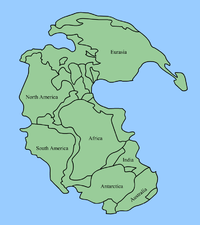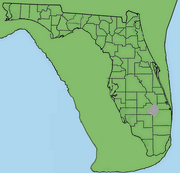User:Noles1984/Sandbox1
Florida Stages Development
Stages of development[edit]

What is now the Florida peninsula was part of an unnamed supercontinent during the late Precambrian ~700 million years ago with the current continents of North America, South America, Africa, Europe, and other land masses. Just over 600 Mya., this large landmass began to break up with N. America and Africa having the most dynamic movement. Tectonic movement pushed the landmasses together once more forming the named supercontinent Pangaea.[1] The tectonic movement with Pangaea continued until around 200 Mya. with the continents coming to what is their present-day locations.
Florida was a part of Northwest Africa with recent geology displaying distinct similarities between Florida's igneous and metamorphic rocks as well as basement rocks and subsurface sandstone, siltstone and shale found in northwest Africa. Various magnetic properties within the Florida Paleozoic rocks also match better with those of Africa than those of North America.
Jurassic[edit]
During the mid-Jurassic, proto-Florida was complete. The basaltic crust of the relatively new Atlantic Ocean floor basin cooled, shrank, while accumulating sediment also forced the crust beneath the basin to sink.
Cretaceous[edit]
During the Cretaceous ~145.5—65.5 Mya, the carbonate Florida Platform developed with limestone, harder dolostone, and carbonate sediments from dying algae or seaweed which secretes calcium carbonate crystals, and organisms which made-up coral reefs continuing to accumulate to the present day. This process was also at work on the Bahama Banks.[2]
The oldest known fossil to have been recovered in Florida was near Lake Okeechobee when a well core brought up a partial skeleton of an aquatic turtle Chelonioidea from a depth of 9,210 feet. The core hole just happened to be in position to penetrate the rocks where the fossil was embedded.
Eocene[edit]
The oldest rocks that occur at or near the surface in Florida are Middle Eocene ~45 Mya. Fossils from Jackson County yielded Anthozoa, Porifera.
- Panhandle: Avon Park Formation, Ocala Limestone, and some residual sediments on Eocene sediments.
- Northern peninsula: Avon Park Formation Ocala Limestone.
- Southern peninsula: Avon Park Formation Ocala Limestone.
Oligocene[edit]
Florida's first emergent landmass, Orange Island, has set position. To its north is the Gulf Trough.

- Panhandle: Suwannee Limestone-Marianna Limestone and residual on Oligocene sediments.
- Northern peninsula: Suwanee Limestone.
- Southern peninsula: Suwanee Limestone, Oligocene-Pliocene H.G Arcadia Formation, and H.G. Acadia with Tampa Member.
Miocene[edit]
The first land mammals enter Florida with the Gulf Trough now filled in.
- Panhandle: Alum Bluff Group, Chattahoochee Formation, St. Marks Formation, H.G. Torreya Formation, and residual on Miocene sediments.
- Northern peninsula: Hawthorne Group, H.G. Coosawhatchie Formation, H.G Charlton Member, and H.G. Statenville Formation.
- Southern peninsula: Hawthorn Group Acadia Formation, H.G. Peace River Formation, H.G. Peace River and Bone Valley Formation.
Pliocene[edit]
- Panhandle: Alum Bluff Group, Jackson Bluff Formation, Citronelle Formation, Intracoastal Formation, and Miccosukee Formation.
- Northern peninsula: Plio—Pleistocene undifferentiated sediments, Cypresshead Formation, reworked Cypresshead sediments, and dune.
- Southern peninsula: Hawthorn Group Peace River Formation, H.G. Peace River and Bone Valley Formation, Tamiami Formation, Cypresshead Formation, and dunes.
Pleistocene[edit]
The Pleistocene is composed of
- Wisconson glaciation
- Sangamonian interglacial
- Illinoian glaciation
- Pre-Illinoian interglacial period of 2.588 Ma.—500,000 years ago
The Pre-Illinoian is composed of glacial and interglacial names no longer recognized by most geologists. From oldest to youngest: Nebraskan, Aftonian, Kansan, and Yarmouth.
- Panhandle: Pleistocene undifferentiated sediments, Alluviam, and Beach ridge and dune.
- Northern peninsula: Beach ridge and dune, Trail Ridge sands, reworked Cypresshead sediments, Plio-Pleistocene undifferentiated sediments, dunes, Pleistoceine undifferentiated sediments, and Anastasia Formation.
- Southern peninsula: Reworked Cypresshead sediments, dunes, Plio-Pleistocene shelly sediments, Pleistocene undifferentiated sediments, Tamiami Formation, Anastasia Formation, Caloosahatchee Formation, Miami Limestone, Key Largo Limestone.
 |  |  |  |
Florida consists of Paleogene carbonate rocks with a small percentage of gypsum and anhydrite in the form of evaporates. The peninsula also consists of Neogene-Quaternary quartz sands, silts, clays and some evaporites formed when sea water did not circulate allowing evaporation to concentrate the minerals in solution. The minerals were then deposited along with the carbonate sediments.
The Florida Platform was unable to emerge due to the swift Gulf Trough carrying away sediments. During
The oldest sediments which are exposed are Middle Eocene carbonates found in the Avon Park Formation. Most of the state of Florida is covered by Pliocene, Pleistocene, and Holocene siliciclastic-bearing sediments deposited during sea-level fluctuations and filling in of the Gulf Trough beginning in the late Tertiary and Quaternary.
The sediments deposited during the Neogene are primarily quartz sands, silts, and clays with varying amounts of limestone, dolostone, and shell. With the exception of the Pliocene Tamiami Formation in southwestern Florida, the Neogene carbonates occur as thin beds and lenses disseminated in the siliciclastic sediments. Deposits composed primarily of shells with subordinate amounts of sands and clays become very common in the Pliocene over much of Florida.
